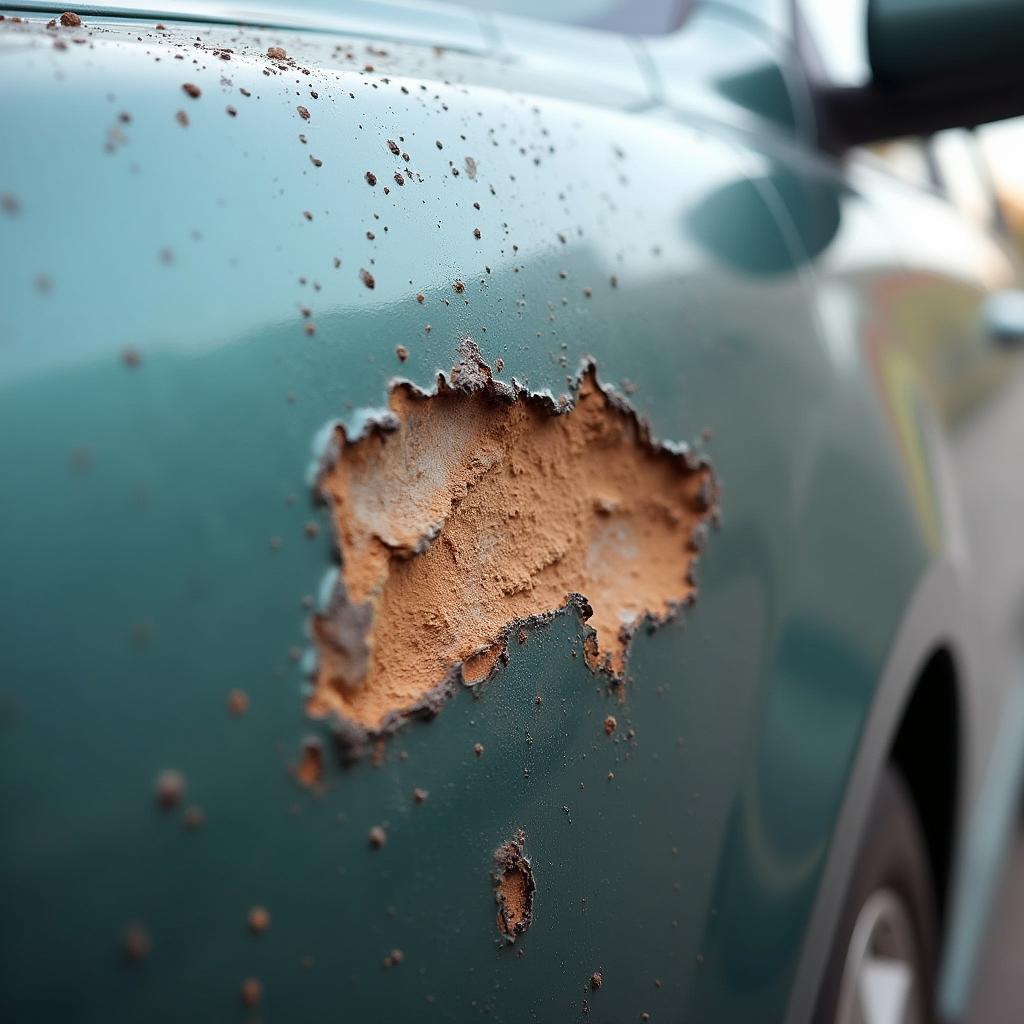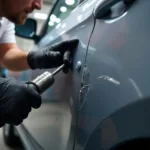A paint chip on your car might seem like a minor annoyance, but it can quickly escalate into a much larger problem if left untreated. Rust, diminished resale value, and even safety hazards are all potential consequences of ignoring those pesky little chips. Fortunately, repair paint chip car methods range from DIY fixes for minor blemishes to professional interventions for more serious damage. This guide will equip you with the knowledge to address paint chips effectively and keep your car looking its best.
Understanding Paint Chips: Why They Occur and Why They Matter
Car paint is surprisingly susceptible to chipping. Everyday driving exposes your vehicle to a barrage of tiny projectiles: road debris, gravel, pebbles, even insects. These impacts can cause small pieces of paint to flake off, revealing the bare metal underneath.
While seemingly insignificant, these exposed areas are vulnerable to:
- Rust: Without the protective layer of paint, the metal underneath is exposed to moisture and oxygen, the perfect recipe for rust formation.
- Further Paint Damage: Chips can spread and worsen over time, especially if exposed to harsh weather conditions or left untreated.
- Reduced Resale Value: Even small, unaddressed paint chips can significantly lower your car’s resale value.
DIY Repair Paint Chip Car Solutions: Quick Fixes for Minor Damage
For small, shallow chips, DIY solutions can be an effective and affordable option.
Touch-Up Paint: Your Go-To for Minor Chips
Touch-up paint is a readily available and easy-to-use solution. You can typically find it at auto parts stores or online. Here’s a step-by-step guide:
- Clean the Area: Thoroughly wash and dry the chipped area to remove any dirt, wax, or debris.
- Apply Primer (If Necessary): If the chip exposes bare metal, apply a thin coat of automotive primer and let it dry completely.
- Apply Touch-Up Paint: Carefully apply thin coats of touch-up paint to the chip, allowing each layer to dry completely before applying the next.
- Level the Surface: Once the paint is dry, use fine-grit sandpaper (2000-grit or higher) to gently level the surface.
- Apply Clear Coat: For added protection and shine, apply a clear coat over the repaired area.
Paint Chip Repair Pens: Convenience in Your Pocket
Paint chip repair pens combine primer, paint, and a clear coat in a single, easy-to-use applicator. They are ideal for minor chips and scratches.
DIY Repair Kits: Addressing Deeper Chips
DIY repair kits offer a more comprehensive solution for deeper chips that expose the metal underneath. These kits typically include a bonding agent, putty, sandpaper, and touch-up paint.
When to Call the Professionals: Signs You Need Expert Help
While DIY solutions are suitable for minor chips, more severe damage often requires professional professional car paint chip repair to restore your car’s finish. Consider seeking professional help if:
- The Chip is Large: Chips larger than a pencil eraser are often best left to professionals.
- Rust is Present: Rust requires specialized treatment to prevent it from spreading.
- The Damage is Deep: Deep chips that expose multiple layers of paint require professional expertise.
Professional auto body shops have the experience, tools, and color-matching expertise to achieve a seamless repair.
Preventing Future Paint Chips: Protecting Your Car’s Finish
While some paint chips are unavoidable, you can take steps to minimize the risk and keep your car looking its best:
- Regular Washing: Regularly wash your car to remove dirt, grime, and corrosive substances.
- Waxing: Applying a coat of wax every few months provides a protective barrier against minor scratches and chips.
- Parking Strategically: Park your car in a garage or carport whenever possible. If you have to park outside, try to avoid parking under trees or in areas prone to flying debris.
- Maintain a Safe Following Distance: Maintain a safe distance from the vehicle in front of you to reduce the risk of rocks or other debris being kicked up by their tires.
Choosing the Right Repair Option: Factors to Consider
Deciding between DIY and professional chipped paint car repair depends on various factors:
- Severity of the Damage: Assess the size, depth, and location of the chip.
- Your Budget: DIY solutions are generally more affordable, while professional repairs can be more costly.
- Your Skill Level: Be honest about your DIY skills and comfort level.
Remember, seeking professional help for significant damage often results in a higher-quality and longer-lasting repair.
Conclusion: Don’t Let a Small Chip Become a Big Problem
Addressing paint chips promptly is crucial for maintaining your car’s appearance, protecting its value, and preventing further damage. Whether you opt for a DIY solution or seek professional help, remember that proactive care is key to keeping your car looking its best for years to come. If you’re unsure about the best course of action, don’t hesitate to consult with a trusted auto body professional for personalized advice and a cheap car paint chip dent repair san diego.



